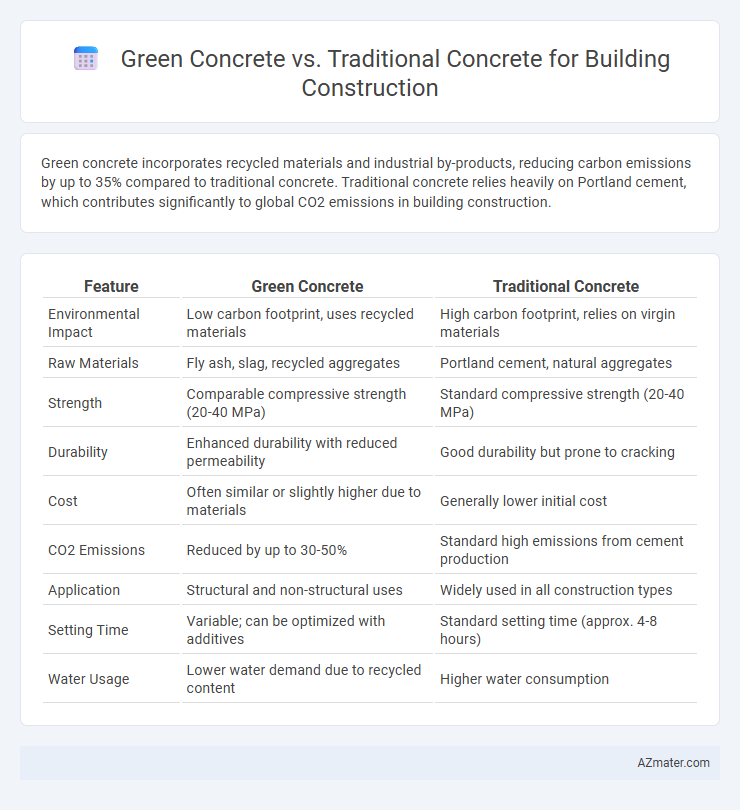Green concrete incorporates recycled materials and industrial by-products, reducing carbon emissions by up to 35% compared to traditional concrete. Traditional concrete relies heavily on Portland cement, which contributes significantly to global CO2 emissions in building construction.
Table of Comparison
| Feature | Green Concrete | Traditional Concrete |
|---|---|---|
| Environmental Impact | Low carbon footprint, uses recycled materials | High carbon footprint, relies on virgin materials |
| Raw Materials | Fly ash, slag, recycled aggregates | Portland cement, natural aggregates |
| Strength | Comparable compressive strength (20-40 MPa) | Standard compressive strength (20-40 MPa) |
| Durability | Enhanced durability with reduced permeability | Good durability but prone to cracking |
| Cost | Often similar or slightly higher due to materials | Generally lower initial cost |
| CO2 Emissions | Reduced by up to 30-50% | Standard high emissions from cement production |
| Application | Structural and non-structural uses | Widely used in all construction types |
| Setting Time | Variable; can be optimized with additives | Standard setting time (approx. 4-8 hours) |
| Water Usage | Lower water demand due to recycled content | Higher water consumption |
Introduction to Green Concrete and Traditional Concrete
Green concrete utilizes industrial waste materials like fly ash, slag, and recycled aggregates to reduce environmental impact, offering enhanced sustainability in building construction. Traditional concrete primarily consists of cement, water, sand, and aggregates, which results in higher carbon dioxide emissions due to cement production. Green concrete demonstrates lower embodied energy and improved durability, making it a viable alternative for eco-friendly construction projects.
Composition and Material Differences
Green concrete incorporates industrial by-products such as fly ash, slag, or recycled aggregates, reducing the use of Portland cement, which lowers carbon emissions compared to traditional concrete. Traditional concrete primarily consists of cement, water, sand, and natural aggregates like gravel, relying heavily on cement whose production is energy-intensive and emits significant CO2. The substitution of cement with supplementary cementitious materials in green concrete enhances sustainability by utilizing waste materials and decreasing environmental impact while maintaining structural integrity.
Environmental Impact Assessment
Green concrete significantly reduces carbon dioxide emissions by utilizing industrial byproducts such as fly ash and slag, lowering the overall environmental footprint compared to traditional concrete. Its production consumes less energy and decreases the extraction of natural resources like limestone and sand, contributing to sustainable construction practices. Environmental Impact Assessment reveals that green concrete improves waste management and reduces landfill use, promoting eco-friendly building construction.
Strength and Durability Comparison
Green concrete, incorporating recycled materials and industrial by-products like fly ash or slag, often matches or exceeds the compressive strength of traditional concrete, making it suitable for various structural applications. Its enhanced durability arises from reduced permeability and improved resistance to chemical attacks, resulting in longer service life and lower maintenance costs compared to conventional Portland cement concrete. Studies confirm that green concrete's microstructure contributes to superior performance under environmental stressors, supporting sustainable building construction without compromising structural integrity.
Cost Analysis: Initial and Long-Term
Green concrete often involves higher initial costs due to the use of eco-friendly materials like fly ash, slag, or recycled aggregates, but these can be offset by reduced energy consumption and lower environmental impact during production. Traditional concrete generally has lower upfront expenses due to widely available raw materials and established manufacturing processes. Long-term cost benefits of green concrete include enhanced durability, reduced maintenance expenses, and potential savings from regulatory incentives or carbon credits, making it economically competitive over the building's lifecycle.
Workability and Construction Techniques
Green concrete, incorporating recycled materials and industrial byproducts, often exhibits improved workability due to optimized particle packing and enhanced water retention, facilitating smoother mixing and placement compared to traditional concrete. Construction techniques for green concrete may require adjustments such as modified curing regimes or specialized admixtures to accommodate its unique hydration properties and ensure structural performance. Incorporating green concrete can lead to sustainable construction practices without compromising ease of handling or adaptability on-site.
Energy Efficiency and Thermal Performance
Green concrete significantly enhances energy efficiency and thermal performance in building construction by incorporating recycled materials and industrial by-products like fly ash and slag, which improve insulation and reduce heat transfer. Its lower thermal conductivity compared to traditional concrete helps maintain stable indoor temperatures, reducing the dependence on heating and cooling systems and thereby cutting energy consumption. Sustainable formulations in green concrete also contribute to reduced carbon emissions during production, promoting eco-friendly building practices without compromising structural integrity.
Regulatory Standards and Certifications
Green concrete complies with stringent regulatory standards such as ASTM C595 and EN 450-1, emphasizing reduced carbon emissions and enhanced durability by incorporating recycled materials and industrial by-products. Traditional concrete primarily adheres to standards like ASTM C150 for Portland cement, focusing on performance parameters without significant environmental considerations. Certifications like LEED and BREEAM favor green concrete for sustainable building construction, promoting resource efficiency and lower environmental impact, while traditional concrete lacks such comprehensive sustainability certifications.
Case Studies and Real-World Applications
Green concrete, incorporating industrial by-products like fly ash and slag, has demonstrated significant environmental benefits in case studies such as the Lendlease Barangaroo South project in Sydney, which achieved a 70% reduction in carbon footprint compared to traditional concrete. Real-world applications in infrastructure, including the Diamond Exchange District in Amsterdam, reveal that green concrete offers comparable compressive strength and durability while enhancing sustainability metrics. These implementations underscore green concrete's viability in reducing carbon emissions and resource consumption without compromising structural integrity in large-scale building construction.
Future Trends in Sustainable Concrete Solutions
Green concrete, incorporating recycled materials and industrial by-products like fly ash and slag, reduces carbon emissions and enhances durability compared to traditional concrete. Future trends emphasize nano-engineered additives, carbon capture integration, and bio-based binders to further lower environmental impact and improve performance. Innovations in real-time curing monitoring and 3D printing with green concrete are set to revolutionize sustainable building construction.

Infographic: Green concrete vs Traditional concrete for Building construction
 azmater.com
azmater.com